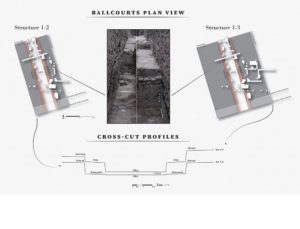
The ritual ball games and ball playgrounds were more common in the pre-Columbian cultures of Central America than was long thought, as is now proven by the discovery of a 3400 year old ball playground in Oaxaca, Mexico. This ball playground is around 800 years older than all previously known from the highlands and was created at the same time as the oldest ball playground in the lowlands. This suggests that these rituals were created almost simultaneously in different regions of Central America.
“Playing with the rubber ball is one of the fundamental characteristics of ancient Central America,” said Jeffrey Blomster and Victor Salazar Chavez of George Washington University in Washington DC. Archaeologists have now found more than 2,300 pre-Columbian ball playgrounds in Mexico, Guatemala, Belize, Honduras and El Salvador – many of them in cities of the Maya and Aztecs. For these peoples, the ball game was primarily of ritual importance, it was considered a competition between heroic mortals and the gods of the underworld, as the Popol Vuh of the Maya reports. Many ball player figures and murals also testify to the great importance of these games.
Puzzle about the origin of ball games
But when and where the ritual ball games of the Mesoamerican peoples originated is so far largely unclear. However, because the ball used for these games consisted of the rubber of the Panama rubber tree (Castilla elastica), which is predominantly found in the lowlands, archaeologists have previously assumed that ball games also developed in the lowlands of Central America. In addition, the by far oldest known ball playground, Paso de la Amada, was built around 1650 BC in the lowlands of southern Chiapas in Mexico.
“These discoveries and the lack of documented ball courts in the highlands until about a millennium after the earliest lowland spots seemed to support an origin of this tradition in the lowlands,” said Blomster and Chavez. However, excavations in Etlatongo in the Mexican highlands of Oaxaca have now refuted this assumption. There the researchers discovered the remains of two successively built ball playgrounds. The older of the two dates back to around 1374 BC. “The Etlatongo ball playgrounds are the oldest known from the highlands of Central America,” the scientists report. “The older of the two is 800 years older than that from the central highlands and 1000 years older than any other ball court in Oaxaca.”

Classic system 3400 years ago
Despite their age, both of Etlatongo’s ball playgrounds already follow a typical architectural plan. The older of the two is constructed in a similar way to the Paso de la Amada square in the lowlands, which is about the same age, as the archaeologists explain. It was around 25 meters wide and 46 meters long. In the center was a rectangular playing surface, the floor of which consisted of smooth and probably red painted rock. Rows of stone benches framed the playing field on both long sides, while the two front ends ended in vertical walls. Embankments filled the entire inner area.
Only around 20 centimeters above the top layers of this first ball playground, the archaeologists found the remains of a second square, which had been created directly above the first and in the same orientation. “This second place shows substantial changes in the layout, including the removal of the benches and higher and thicker side walls,” report Blomster and Chavez. “These changes could indicate variations in the game.” According to their estimates, the two ball courts were used together for around 175 years. Between 1174 and 1102 BC A decisive event – possibly a fire – then seems to have put an end to the use of the ball playgrounds. This is evidenced by traces of fire on the playing field and on the walls of the younger square.
From the discovery of the Etlatongo ball playgrounds, the researchers conclude that the previous assumption of the origin of these ritual games cannot be correct only in the lowlands of Central America. Instead, the cultures in the highlands were also involved in their development: “We conclude that the highland residents of the early educational era played an important role in the origin of the Mesomamerican ball game,” stated Blomster and Chavez. “This later developed into an institution that shaped the ritual and political life of the following states for two millennia.”
Source: Jeffrey Blomster and Victor Salazar Chavez (George Washington University, Washington, DC.), Science Advances, doi: 10.1126 / sciadv.aay6964